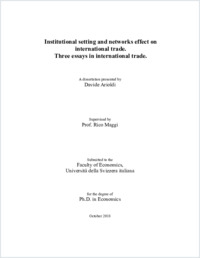Institutional setting and networks effect on international trade : Three essays on international trade
- Arioldi, Davide
- Maggi, Rico (Degree supervisor)
-
12.10.2018
161 p
Thèse de doctorat: Università della Svizzera italiana, 2018
International trade
Olympic games
Mega-events
Liberalizations
Legal origin
Currency invoicing
Bargaining power
Network structure
Market shares
Spatially correlated preferences
Trade network
Extended gravity
Spatial exporters
English
This thesis explores the role of different measures of proximity on some topics related to international trade. We focus on how institutional setting (institutional proximity) and network structure (cognitive and social proximity) influence the geography of international trade. In the first chapter, we extend the results of Rose and Spiegel (2011) and the findings by Bista (2017) proposing a source of heterogeneity for the Olympic effect: the institutional channel. We prove that the Olympic effect is only a member of the broader Mega-events effect and we find different liberalization behaviors among legal families after bidding for the event. In the second chapter, we apply a new index of bargaining power in communications network to the choice of invoicing currency. Our bargaining index is derived implementing the Calvo- Aremngol (2001) index in a weighted and directed network. Our aim is to understand whether the exporter and importer’s sector bargaining powers (defined by the relative trade positions in the network of communications) have a role in the currency choice. With highly disaggregated Italian export and import customs data, we document a significant impact on the invoicing currency decision of our bargaining power index. Importers (exporters) with greater bargaining power tend to price their traded goods in the local (producer) currencies. In the third chapter of this thesis, we incorporate the empirical evidence of “extended gravity” and spatial exporter effects into the gravity model of trade with heterogeneous firms developed by Chaney (2008). Introducing country pairs and spatially correlated preferences in the consumers’ utility, we explain most of the network effects found by previous scholars. Our results are confirmed in a structural estimation of the model on a subset of products and countries. We identify the spatial correlation parameter of consumers’ preferences considering, in a custom union, the ratio of export to the same country from different countries, in order to control for observed and unobserved fixed costs to export, using a Monte Carlo Markov Chain (HMC) estimator.
- Language
-
- English
- Classification
- Economics
- License
-
License undefined
- Identifiers
-
- RERO DOC 328795
- URN urn:nbn:ch:rero-006-120018
- ARK ark:/12658/srd1319381
- Persistent URL
- https://n2t.net/ark:/12658/srd1319381
Statistics
Document views: 327
File downloads:
- Texte intégral: 134
